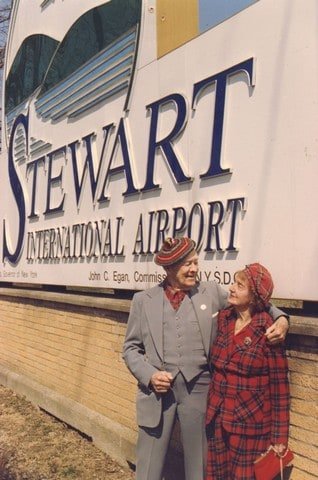
The Brothers Wright made their historic flight at Kitty Hawk in September 1903 some eighteen months after my birth. I cannot recall a time when I was not interested and fascinated by “airships”. I thrilled to watch Glenn Curtis make the first Albany to New York City flight in 1910.
My first ride in an aircraft took place at Coral Gables, Florida during the winter of 1921. My first ride in a commercial aircraft occurred in 1931 or 32. It was a Ford Trimotor that flew regularly scheduled flights from New York to Boston with a stop at Hartford. I learned to fly in the Fall of 1932.
It was at this time that I came to the conclusion that travel in the future would be in the air. In this connection, I decided that every community should have a place where aircraft could operate. I felt that a community without such an operation during the developing twentieth century would be in a situation similar to a community without a railroad a hundred years earlier.
At that time our family-owned two farms to the west of the City of Newburgh. The larger farm began at the west end of the City and occupied the area between 17K and the South Plank Road and west to Union Avenue. It was used by my Father Thomas W. Stewart for the production of ice for the City. The other half of the farm was used by my Uncle Samuel L. Stewart for his devoted hobby, the production of Certified Raw milk. In this endeavor for a period of over twenty years, he produced the purest milk in the entire World from a bacteriological count. (“I have documents sustaining this fact”).
ZMap of the various Stewart Held Properties and Farms with later roads (Route 84) overlaid. (Provided by the StewartHafer Families)The second farm was two miles farther west on 17K and was on the south side of the road. From about 1895 until 1906 my Father used this farm for his business of pasturing New York City horses with sore feet. This condition was brought about by the horses having to walk on cobblestones with which the City was paved. The horses were pastured there from Spring through Fall. Uncle Sam used the farm until about 1920 for the pasturing of his dry cows. (Cows which were not milked for three or four months prior to giving birth to calves.)
The eastern farm was called Brookside. It contained the Brookside Ice Company and the Brookside Dairy Farm. The former supplied the City with ice before the event of mechanical refrigerators. The second, Brookside Dairy Farm, sold half of its production of Certified Milk in the City of Newburgh. The other half was expressed each afternoon to New York City. There it was distributed in a few specialty stores for the highest price in the City.
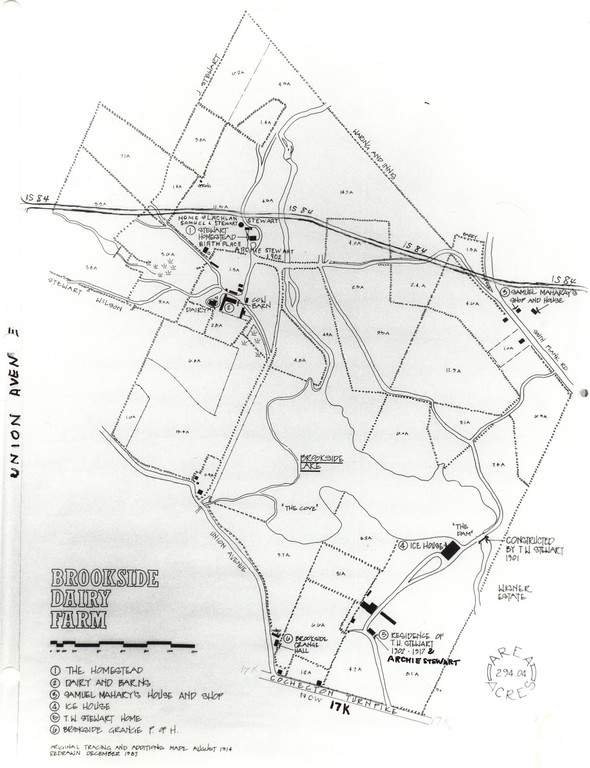
The western farm was called Stony Lonesome. As previously indicated, neither of the Stewart brothers used it after 1920. There was a narrow old lane that ran south from the Cochecton Turnpike (17-K) to the foot of Bullet Hill. A large wooden gate blocked the entrance to this road. During the period that I attended Union Grove school, I sometimes road my quarter horse down this lane when my purpose was to dig lead bullets out of the hill. About a hundred yards or so to the west the remains of a few old cellars could be seen. There were places where some houses once stood. By the looks of things, it seemed to me that they could have been there until around the time of the Civil War. By 1930 and not having been used for at least ten years, the entire area had grown up to dense brush and trees.
Firmly convinced that future long-distance travel would be by air I approached my Father one day and explained my feelings. I pointed out that he had not used Stony Lonesome since about 1906 and Uncle Sam since about 1920. Because it had been sitting idle and not used by the Family, I proposed that it be given as a memorial to his Father to be used by the Community for the purpose of Aviation. He thought it over for a few moments and said. “Your suggestion sounds alright to me, but you will have to run that by your Uncle Sam. He is the senior in the Family, and it is he who will have to make the final decision. Uncle Sam was easy. Always interested in anything beneficial to the community he told me to go ahead with my idea and that he would sign whatever necessary for transferring the property to the City of Newburgh. (Upon his death in 1936 the New York Times carried a long article listing his philanthropies and public beneficiaries).
In the deed transferring Stony Lonesome to the City Uncle Sam had an important clause inserted. It was that the property was to be used for the purpose of aviation. In the event that it was not the land was to revert to the Family. Not because the Family wanted it back but to make certain that it would be used for the intended purpose.
The City proceeded to slowly develop the property. It was during the Roosevelt Depression and available funds were severely limited. A swath about two hundred yards wide and half a mile long parallel to 17K was cleared of trees and the stumps burned.
At this time the Chief of Staff in Washington was General Douglas Mac Arthur. He came to the conclusion that a certain number of cadets graduating from West Point each year should be taught to fly. Before that could be accomplished West Point would have to have a “Field”, as they were called at that time. To this end he sent a member of his Staff up to see me. This was Major George J. Richards who later became a Major General. Major Richards flew from Washington to a little airstrip on the north side of 17K just east of the Village of Montgomery. He was met there by me and a former member of his staff, Lieutenant Kenner F. Hertford, who later also became a Major General.
Kenner and I drove Major Richards to the sight being developed. He pronounced it ideal for what General MacArthur had in mind and so reported. I assured Major Richards that the City would be most happy to transfer the land to the Government. I pointed out that where the City could only spend hundreds, the Federal Government would be able to spend millions. This proved to be the case for at about this time a chap by the name of Adolph Hitler was beginning to be recognized as a potential threat.
At about this point I wrote a letter to the Chief of staff in Washington. In my letter, I stated that during the entire transaction neither I nor any member of my Family had benefitted in any manner whatsoever. However, I now had a favor to ask. I asked to be permitted to name the first commanding officer for the new airfield. In my letter, I stated that I wouldn’t think of making such a request if I wasn’t sure that the officer I had in mind was the best possible choice from the standpoint of West Point, the Army Air Corps, and the U. S. taxpayer. I then proposed the name of my very dear friend John H. Weikert who at the time was a Captain. He too became a Major General later in his career.
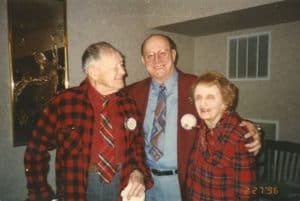
A few days later I received a letter from the office of the Chief of Staff in Washington dated 6 February 1937 which read; “Dear Mr. Stewart: It was decided that your call on Captain Weikert should be given preference and he is to be detailed to duty at West Point. Please do not give out the information concerning the detail of Captain Weikert until it is made public by West Point on War Department published orders.”
While not an architectural engineer “PD” Weikert* performed the magnificent job that those of us who knew him were sure that he would. The airport today is largely the way he laid it out and designed it. While he was here WWII broke out and with all sorts of shortages and obstacles, he accomplished the task in a surprisingly short time. The War Department wanted to use Quonset Huts and corrugated metal construction. Captain Weikert insisted and hung out for brick and permanent design and material. That is why it has lasted and today looks much as it did when he finished.
* Upon arriving at West Point the upperclassmen nicknamed him P.D. for Pennsylvania Dutchman. That moniker remained with him throughout his entire life. Many friends and acquaintances thought they were truly his initials, which are, J.M. for John Maurice.
On the morning of 7 December 1941, the day the Japanese bombed Pearl Harbor, I drove out to Stewart Field and met an officer who had come to Newburgh to take delivery of a new Buick which I had sold him. (Because of the time differential it would still be several hours before the Japanese arrived). I drove the officer back to the office where we completed the transaction. This was done in plenty of time to permit my returning home, have dinner and line up in front of the radio to enjoy a most important football game which would be played in New York City.
That same morning, and at about the hour I was meeting the officer at the Field, P. D. Weikert, then a Lieutenant Colonel, received a telephone call. It was from the Superintendent of the Military Academy. The call stated that P. D. was come to his home at about 11am. You may rest assured that P. D. arrived promptly at the appointed hour. Upon arriving General Eichelburger removed the silver leaves from his shoulders and replaced them with eagles. And this too was accomplished with time to permit P. D. to eat and listen to the game.
I am sure that by now every schoolchild knows how the announcer interrupted the football program to excitedly announce that the Japanese were destroying our Fleet which was stationed at Pearl Harbor, Hawaii. By a coincidence that evening P. D. and I with our wives attended a big cocktail party at the Home of Eddie O’Neil, a Newburgh attorney. It was a most memorable event.
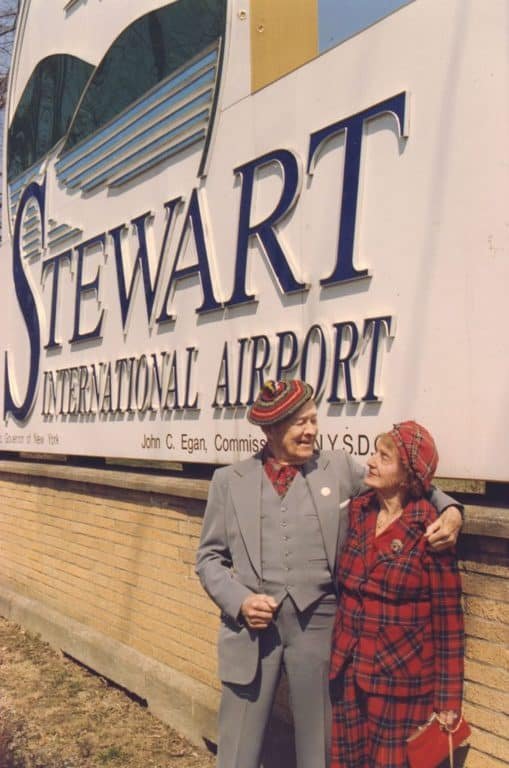
Shortly after the war began, I decided that the Country had been exceptionally good to me and to all the members of my family. Now that the ship was taking on water, I wanted to get my hands on a pump. Being too old for the draft I volunteered. After some delay and because of my automotive experience I was commissioned a Captain in Ordinance and ordered to the Tank Automotive Center in Detroit. A few months later I transferred to the Army Air Corps and was assigned to the Rouge Plant of the Ford Motor Co. in Dearborn. There I was made assistant to the Commanding Officer, Lieutenant Colonel P. G. Hart. Colonel Hart proved to be one of the finest gentlemen I have ever known and remained one of my dearest friends for the rest of his life. When the Colonel left, I succeeded him as Commanding Officer. My Command consisted of about twenty-five Commissioned Officers, a few Enlisted Personnel, and about four hundred civilian inspectors and accountants. The nicest event of my memorable tour at Ford’s occurred when, as the end of the War approached, Mr. Ford asked me to stay on as a member of the Company.
Colonel Weikert the Commanding Officer of Stewart Field and Major General Willoughby, Superintendent of West Point, officially dedicated the Field on 20 August 1942. While not here in Newburgh I learned from the newspaper that the Field was a beehive of action throughout the War. Aircraft from Stewart patrolled the skies of the Northeast looking for enemy submarines and any sort of hostile activity.
At the end of the hostilities, Stewart Field became of tremendous importance to the Nation. From the position of Ally, Russia soon became a potential enemy and a dangerous threat to The United States and Canada. This came about by the distinct possibility of Russian Aircraft equipped with atomic bombs flying over the North Pole. To try and counter this menace the United States and Canada constructed a line of observation radio stations along the Arctic Circle stretching from Alaska across Northern Canada to Iceland. The DEW line became the well-known acronym by which this system was known. The letters stood for Distant Early. Each one of these stations fed by wire directly into the Sage Building at Stewart.
Because of its importance, this building was one of the most powerfully constructed structures in the World. It was designed to withstand everything but a direct atomic hit. The Base thus became the Headquarters for the defense those portions of the United States and Canada lying east of Chicago.
The Base continued that vital position until Russia developed atomically equipped Intercontinental Ballistic Missiles. With the threat of bombers coming over the North Pole no longer likely, the War Department felt Stewart Air Force Base to no longer be vital. The Base was then turned over to the State of New York.
During the years that it was of such importance to the Nation’s defense, it became the Headquarters of the Eastern Air Defense Command. As such it was commanded by Major Generals. I had the pleasure of becoming well acquainted with each of these gentlemen. Without exception, they were officers of outstanding qualifications. One, in particular, stands out. He was Major General Morris R. Nelson who was stationed here from June 1952 until 1956. To his countless friends in the area, he was known by the very decidedly unmilitary sounding nickname of “Nellie”. Even his lovely wife Lucile called him that. After they left here Mary and I often visited them at their home in Falls Church, Virginia.
During the years of 1988 and 1989 rumors began to circulate that regularly scheduled airline service might soon occur at Stewart. As these stories developed and became more persistent, I decided it might be time for action on my part. For years I had hoped I might live to see this and long looked forward to this event to take place. Now that the possibility seemed to be shaping up, I decided to take action. I visited my travel agent and told him if, and when, commercial service took place, I would like to be on the first flight. I reminded him of the fact that of the many flights on which he had booked me over the years, I had always sat in the back of the aircraft. This time, however, if I was to depart from Stony Lonesome, I wanted to sit in the front of the bus. I next inquired as to what the price might be to California and back. His reply, “about $2,000.00 per ticket”. “Order six”, was my most uncharacteristic reply.
In contemplation of scheduled commercial passenger service from Stewart, I decided I would wish to be accompanied by the closest members of my Family. These would, of course, be my wife and two daughters. I soon realized the girls would wish to be accompanied by their husbands. That brought the number of tickets to six. When the time for departure arrived Major Sauls flew here from California with our daughter Anne. Colonel Hafer who was to accompany Mary was sick, so our oldest grandchild Tom Hafer took his Father’s place.
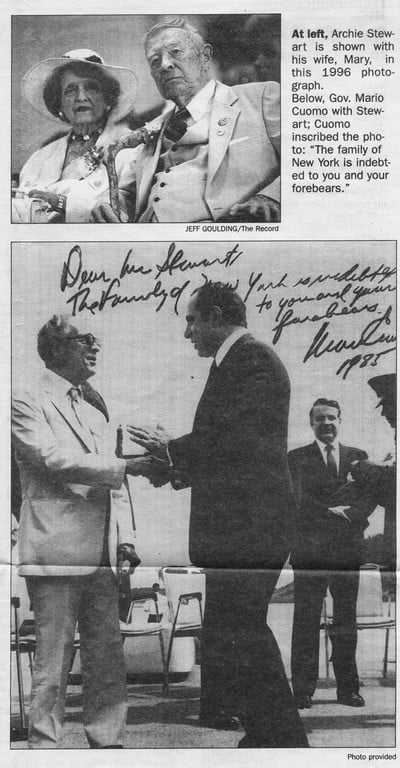
On 29 October 1989, Governor Cuomo and American Airlines officials came to Stewart with the most welcome and gratifying announcement. American Airlines would commence regularly scheduled service from Stewart the following Spring.
My joy and happiness was indescribable. My dream of nearly sixty years was about to be realized. Then, to add even more frosting to the cake, three officials from American Airlines came to me. They were Robert Smith, Richard Kimball, and Emil Sokol. They explained that they were aware of my having six first-class seats on order for the first flight. They, however, were making a “slight” change in my plans. The six tickets would be a gift from American.
From the moment of the announcement by Governor Cuomo and American Airlines great activity began to take place. American set a date of 17 April 1990 and an enormous amount of work had to be done. The New York State Department of Transportation (DOT) would be responsible for the work and the necessary funds. They awarded the contract to American Airlines. An almost impossible task confronted them, but they made it. Their task was impeded when a bunch of obstructionists threw a monkey wrench into the works. DOT was forced to take the matter to the New York State Supreme Court where the five Judges rendered a unanimous verdict decreeing that the development of the Airport should continue without interruption. A great shell of a building with a roof full of holes had to be made over into a terminal. Parking locations for cars had to be established and developed. Plumbing, heating, telephone, and electrical services had to be accomplished. In spite of these and countless other problems, American was ready on time. On the evening of 16 April, American and DOT hosted an enormous introduction and get-acquainted party in the Terminal Building. Great crews of workers were laboring furiously all day right up to the moment of the reception. If I remember correctly, carpets were still being installed just moments before great crowds began to arrive.
To me, it was one of the most momentous events I have ever attended. Hundreds and hundreds of people came to the appropriately decorated terminal that evening. I signed my name countless times chiefly for persons whom I did not know. American Officials were hosts of the occasion. Also, members of the New York State Department of Transportation. The five members of my family who were to accompany me on the first flight were also in attendance. It seemed that everyone I knew in the area was there together with countless others. The ceremony the following morning was even more impressive.
In answer to a question from one of the reporters or television representatives, I stated that it was the second happiest day of my life. My answer to the obvious follow-up question was, “My wedding day”. Prior to the actual boarding of the aircraft I was asked to cut the ceremonial ribbon. To do this Bob Smith, the head of American Airlines for the area, handed me a pair of scissors fashioned for such occasions. They were about six feet in length just as dull as they were long. After about five or six futile clips and just about the time I was reaching for my jackknife the ribbon parted. This was accompanied by a great cheer from the vast audience.
Our flight to Chicago was a most happy one. Onboard I recognized many friends and acquaintances. I learned later that they made the flight for its historic significance. They had dinner in Chicago and then returned to Stewart the same afternoon. When our party arrived in Chicago, we were met by an American representative who escorted us to our seats on the plane for California. About ten days later the same courtesy and attention was accorded us on our return flights. After being the first passengers to be seated in Chicago I began to wonder if anyone there had ever heard of Newburgh to say nothing of Stewart Airport.
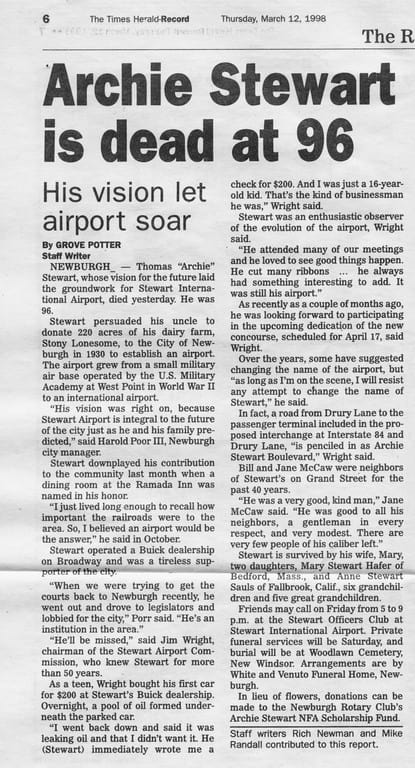
I soon had an answer. To my immense gratification passengers started coming in and continued to do so until every seat was occupied. A short while later on a similar flight, there was a short delay in departure while a larger plane was made available.
I want to acknowledge and express my utmost gratitude to everyone with whom I have come in contact from the time I conceived the idea of using stony Lonesome for purpose of Aviation. At the head of this long list extending over a period of sixty years would put my Uncle Samuel L. Stewart. Without his acquiescence, nothing would have happened. Next would have been the Chief of Staff in Washington, General Douglas MacArthur. As pointed out earlier, if General MacArthur had not intervened, the probabilities are that Stewart Field simply would have remained a little local flying field. Major Generals Richards and Hertford would be next in line for they were the intermediaries between General MacArthur and myself. Then ”P.D.” Major General John M. Weikert would be next in sequence. To him and him alone must go the major share of the credit for the laying out and building of the Airport. He even drew the rough and general plans for many of the buildings. Among these would be the Officer’s Club which he designed in the back seat of a Ford Automobile while riding to New York City one day.
From the time the War Department turned the Airport back to the State of New York each of the Governors has enthusiastically done everything they could to further its development. Nelson Rockefeller was Governor at the time. He saw the need for additional expansion. This would provide room for commercial development and the establishment of a buffer zone to restrict noise west of the Airport. To do this he added eight thousand acres to the airport. Our next Governor, Malcolm Carey made many trips here to keep the project moving forward. As noted earlier through the combined efforts of Governor Cuomo and American Airlines travelers in the Mid-Hudson area no longer have to make the long and sometimes hazardous journey to JFK, La Guardia or Newark.
One day short of three months after American began its historic flight on 17 April 1990, American’s Eagle Division began passenger service from Stewart to J.F.K. in New York City. A few days later, on the first of August United Express began flights from Stewart to Washington’s Dulles International Airport. Sometime later, on 15 October, United added two additional daily trips to Dulles. Then on the first of December, they began flights to Boston’s Logan. In all 1990 was truly a memorable and monumental year for travel and transportation in the Mid-Hudson Region.
While not able to match the stirring events of 1990, 1991 saw much important activity and development at the Airport. On 08 January US Air began service to Pittsburgh and Philadelphia. Soon afterward in March, US Air added additional service to Philadelphia.
On the first day of April 1991, Delta Air Lines came to Stewart with three daily round trips to Atlanta and the South. While Delta did not achieve the initial success accorded American the previous year their passenger loads improved slowly. In 1992 they made schedule changes which materially improved their performance. On the first of April 1992 they gave a party in the Terminal to celebrate their first year at Stewart. At this ceremony, they stated they are now well pleased at the way their business is progressing.
Signed
Archie Stewart
Editors Note:
Archie and Mary Stewart were well known to all in the community throughout the 20th Century. Always with a smile and kind words both Archie and Mary were born and raised in Newburgh New York. The Stewart Family were early 19th Century immigrants. Lachlan Stewart, from Scotland, stowed away on a boat around 1841 and came to the United States and then to Newburgh. The family worked hard and owned a considerable amount of property in and around Newburgh.
As a member of the Rotary Club my dad, Joe Santacroce, met Archie and Mary and he both did work for the Stewarts as a Photographer and also became friends. Prior to Archie’s passing in 1996 he gave my dad a hard copy of this document typed and signed by Archie. I have converted the document in its entirety with only minor grammatical and spelling corrections.
Archie, like my dad, was an avid photographer and filmmaker in addition to his love of airplanes. A collection of his films, edited for content, are linked below. These were provided by the Stewart Family and under license from NorthEast Historic Film.
